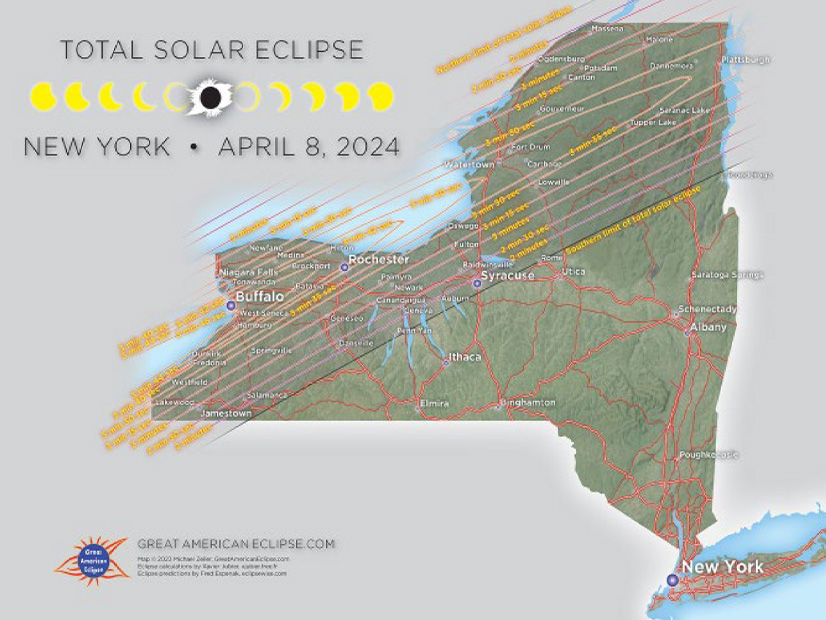Maryland upped the ante on its clean transportation programs Monday as the state finalized its adoption of California’s Advanced Clean Cars II (ACC II) rule and began the process for adopting California’s Advanced Clean Trucks (ACT) rule.
Maryland is the eighth state to adopt ACC II, which will require all new light-duty vehicles sold in the state to be zero emission by 2035.
Gov. Wes Moore (D) announced the state’s intent to adopt ACC II in May. The rule could go into effect as early as January 2026, depending on when automakers begin rolling out their 2027 models, according to a spokesperson for the Maryland Department of the Environment (MDE). For the 2027 model year, 43% of new light-duty vehicles will have to be zero emission, with the share increasing between 6 and 9% per year, reaching 100% by the 2035 model year, according to MDE. (See Maryland to Adopt California’s Advanced Clean Cars II Rule.)
Both electric and hydrogen fuel-cell vehicles are classified as zero-emission vehicles. In addition to California, other states that have adopted the rule include Massachusetts, New York, Oregon, Vermont, Virginia and Washington.
Environment Secretary Serena Coleman McIlwain called Maryland’s adoption of ACC II “a big step toward cleaner air and a more aggressive response to the threats posed by climate change.”
MDE began the process for ACT adoption with a notice of proposed action, requiring truck manufacturers to increase the percentage of new zero-emission trucks sold in the state from 2027 to 2035.
MDE will hold a virtual public hearing on the proposed rule at 10 a.m. Oct. 11. Written comments may be submitted through Oct. 11.
The rule’s targets for clean truck sales vary depending on the type or class of truck. The percentage for Class 2b and 3 trucks, which include vans and heavier pickup trucks (8,501-14,000 pounds), would start at 15% in model year 2027 and rise to 55% by 2035. For heavier-duty Class 4-8 trucks (14,001-80,000 pounds), the zero-emission requirement would be 20% in model year 2027 and 75% in 2035.
MDE’s proposed rule on ACT was mandated under the Clean Trucks Act (H.B. 230) passed by the General Assembly and signed into law by Moore in April. If the proposed rule is finalized, Maryland would be the ninth state to adopt ACT, joining California, Colorado, Massachusetts, New Jersey, New York, Oregon, Vermont and Washington.
Both rules are expected to significantly affect transportation sector greenhouse gas emissions, which account for about 40% of the state’s GHG emissions, according to MDE. By 2035, ACC II is expected to cut carbon dioxide emissions from light-duty vehicles by 63% under 2021 levels, while nitrogen oxide emissions could drop 75% and sulfur oxides 64%, according to an analysis from the Sierra Club.
‘Commonsense Rules’
Special provisions of the Clean Air Act have made it possible for California to enact clean car and truck rules that exceed the vehicle emission standards set by the U.S. EPA. During the administration of former President Donald Trump, EPA revoked the Clean Air Act waiver allowing California’s stricter rules. Under President Joe Biden, EPA reinstated the waiver in March 2022, opening the door for California and other states to adopt ACC II and ACT.
The states that have adopted ACC II will be ahead of Biden’s goal for 50% of new light-duty vehicle sales to be zero emission by 2030.
Environmental and electric vehicle advocates were quick to provide statements of support for Maryland’s adoption of ACC II in a joint press release.
“Every day, fossil fuel cars emit pollutants that intensify climate change and contribute to toxic air pollution,” said Kevin Shen, policy analyst for the nonprofit Union of Concerned Scientists. “By adopting the Advanced Clean Cars II standards, Maryland has chosen to lean into its ambitious climate goals and jumpstart the transition to electric cars, which … will only continue to become even more efficient as Maryland cleans up its grid.”
Tom Van Heeke, senior policy advisor for EV manufacturer Rivian Automotive, called the ACC II standards “commonsense rules to expedite EV adoption in the state of Maryland … especially if combined with the Clean Trucks Act of 2023.”
Ramon Palencia-Calvo, director of the Maryland League of Conservation Voters’ Chispa Maryland program, which is focused on Latino communities, stressed the public health impacts of the new standard.
“Communities of color, low-income communities and neighborhoods near major transportation hubs bear an especially unfair burden of harmful pollution due to decades of systematic marginalization,” Palencia-Calvo said. “Increasing the number of clean vehicles on our roads will reduce respiratory illness and hospitalizations, leading to healthier outcomes.”
Maryland at NYC Climate Week
The actions on clean cars and trucks came as Maryland officials sought to raise the state’s profile as a leader at Climate Week in New York City.
On Monday, MDE announced the state had joined the international Under2 Coalition, with Environment Secretary McIlwain signing the membership agreement. The coalition includes 167 state and regional governments committed to reaching net-zero emissions by 2050. Montgomery County joined the group in 2017, according to the Under2 website.
Joining the coalition “accelerates climate action in Maryland by giving us greater access to technical support and the shared knowledge of more than 160 governments across the world,” McIlwain said. “This action underscores our commitment to building the green economy that will dominate the next century, as well as creating the resiliency to make our state stronger.”
Maryland also is part of the Regional Greenhouse Gas Initiative, a regional cap-and-trade program, and the U.S. Climate Alliance, a bipartisan group of 25 governors committed to meeting the goals of the 2015 Paris climate accords.
Passed in 2022, Maryland’s Climate Solutions Now Act (S.B. 528) sets a 2031 target for the state to cut its greenhouse gas emissions by 60%.
Speaking at the Climate Week opening ceremonies Sunday, Moore made the case for centering climate action on community economic development, especially for low-income and disadvantaged communities.
“Our communities of color — our working parents — our middle-class families: They are the ones who stand to benefit most from our aggressive climate goals. Those are the hands that will install new solar panels at the local rec center. Those are the minds that will invent next-generation wind turbines that power millions of homes,” Moore said.
“This is about whether or not we can dominate industries of the future, instead of relying on industries of the past,” he said. “This is about whether or not we can bring manufacturing jobs home, instead of relying on foreign labor. This is about whether or not the clean energy revolution will close the wealth gap, instead of being just another way to make it bigger.”

